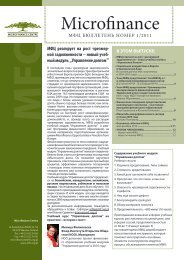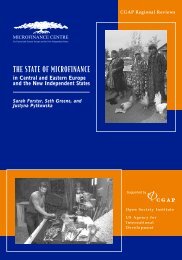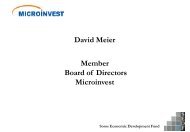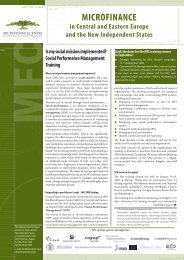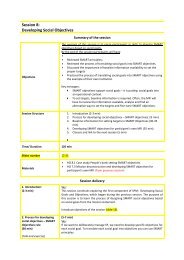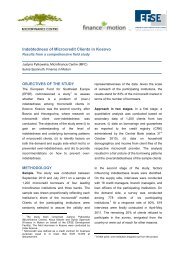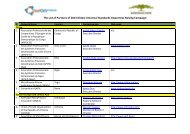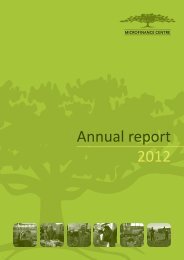Value Chains research report Tajikistan final - Microfinance Centre
Value Chains research report Tajikistan final - Microfinance Centre
Value Chains research report Tajikistan final - Microfinance Centre
Create successful ePaper yourself
Turn your PDF publications into a flip-book with our unique Google optimized e-Paper software.
Inputs<br />
An important factor for productive beekeeping is the delivery of high quality inputs<br />
and easy access to them for beekeepers. To obtain good honey, ideal conditions need to be<br />
created for the bee families.<br />
Bee queens. Bee queens are imported from Transcarpathian region (Western<br />
Ukraine) or Russia (Moscow or the Krasnodar Territory). Existing channels use Uzbek<br />
intermediary companies, though it is also possible to import directly. The demand for<br />
Carpathian breed of bees is high. Russian beekeepers work mostly with the Carpathian<br />
breed, and so do the Tajik beekeepers. A survey conducted among the beekeepers has<br />
shown that they pay up to 30 dollars for each bee queen brought from Uzbekistan. Tagged<br />
bee queens are imported from Russia to Tashkent, then to Begavat and <strong>final</strong>ly to Spitamen.<br />
When importing the bee queens, it is necessary to check their adaptation to the local<br />
climate. Considering the imports are performed by private entrepreneurs, there are no<br />
statistics available for this sector. Now some beekeepers are ready to buy a bee family for<br />
200 Somoni. It is important for beekeepers to update the bees’ genes regularly.<br />
However, this is quite expensive, so the beekeepers agree to purchase the first<br />
generation – a reproduction from the imported purebred bees.<br />
Leading beekeepers can work with other breeds of bees; everything depends on<br />
which breed is demanded in the market and which breeds the beekeepers are ready to buy.<br />
The leading beekeepers buy bee queens once every two years, as breeding stock.<br />
Beekeepers in Khujand have good breeding skills and they are ready to breed and sell the<br />
bees.<br />
Frame bee houses. Bee houses are produced of shaped timber (mostly silver fir)<br />
and consist of the bottom, walls, honey chamber, under-cover, cover, frames and<br />
diaphragms. There are several types of bee houses: long hives and multiple-storey hives.<br />
They are also differentiated by the number of frames, which varies from 10 to 24 pieces. In<br />
<strong>Tajikistan</strong>, the most common type is 12-16 and 20-24-frame long hives.<br />
Bee colonies. A proper bee colony consists from a queen, drones and working bees.<br />
The bee packs are divided into four-frame and six-frame ones. Two frames for sealed brood<br />
(1.2 kg of bees, one laying queen no more than two years old) and two honey and beebread<br />
frames, 1.5 kg for each frame. The six-frame bee packs contain four frames with<br />
sealed brood and two with honey and bee-bread, for a total of 1.6 kg of bees.<br />
Accessories are supplied from Uzbekistan, Russia and Ukraine, where there is a<br />
wide choice, but the problem is these accessories are not always available and affordable<br />
for everyone. Each town that has a large number of beekeepers also has some suppliers of<br />
medical supplies and instruments for beekeeping. Most of the accessories used today are<br />
from old supplies, badly in need of upgrade, and this is becoming a problem for all<br />
beekeepers in <strong>Tajikistan</strong>.<br />
Honey centrifuges. There is a high demand for honey presses suitable for extracting<br />
honey using centrifugal force.<br />
Accessories and boxes are purchased from local craftsmen. The demand for boxes<br />
is extremely high. The most common ones are 12-frame boxes for one family of bees.<br />
110




